Starting Wildflowers from Seed
Posted on Tuesday, August 24, 2021 · Leave a Comment
I recently visited the Nasami Farm in Whately, MA. This is the plant production facility for the Native Plants Trust, formerly the New England Wildflower Society. I met with Alexis Doshas, their nursery manager. The 75–acre farm produces perennials, grasses and some woody plants – mainly from seed. The plants are sold at their headquarters in Framingham, MA, and at the Nasami Farm on weekends.
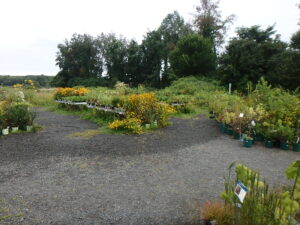
Nasami Farm produces many species of wildflower trees and shrubs from seeds
If you are interested in growing wildflowers, the least expensive way to get plenty is to start them from seed. This takes some effort, but it accomplishes a number of things: if you collect seed from the wild, you are getting plants in your garden without diminishing the wild population – the way you would if you dug plants (which is prohibited anyway in most places).
Starting plants from seed also encourages genetic diversity. Many purchased plants are propagated from cuttings or by division, which means they are all clones with the exact same genes. Seeds from any given plant produce seedlings with a wide range of characteristics, making some less susceptible to environmental challenges such as global warming.
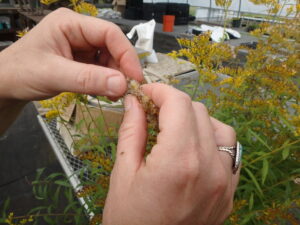
Remove the fuzzy bits to separate seeds before planting
Starting wildflowers from seed can take patience. While some seeds will germinate and grow the same summer you collect them (Campanulas, for example), other things like lilies might take 4 or 5 years to bloom. Many require a cold period of 3 months, which is called cold stratification. Some planted now will grow underground next spring, but not send up any green growth until the following spring.
The Nasami Farm grows seedlings in big plastic hoop houses. These are not heated except in spring, or if temperatures go below zero in winter. The greenhouses allow the seedlings to be monitored and tended easily on long tables. You could set up a table in your barn, shed or garage for a few flats of seedlings. Some wildflowers will do fine in flats with good drainage in the outdoors – preferably in a shady place that won’t see too much of the hot, drying sun.
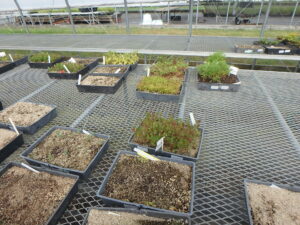
Flats of wildflowers at Nasami Farm
Lastly, you can plant seeds directly in the ground in a site where they will thrive as mature plants. The disadvantage to this is that you never know what percentage of seeds will germinate. If you plant 100 seeds in a flat indoors it will be easier to thin or transplant the seedlings than if you must do so on your hands and knees. And there should be no weed competition if you are using a germination mix in a flat. On the other hand, I plant things like golden seal directly in the ground as it takes 2 years to sprout, and I don’t want to have to water and tend them so long.
Alexis Doshas gave me some tips for success when starting wildflowers from seed. First, she said, collect seed when it is easy to pull off the plant, and remove any fluffy stuff attached to it. Generally seeds start light colored, and darken when fully ripe. If you want to store seed, make sure it doesn’t dry out. Store in a cool, dark place.
Buy a very fine seed germination mix, something made of finely ground peat and perlite. A coarse mix can let seeds wash down deeper than they should be. For small seeds (the size of a grain of sand or less) just sow seeds, pat them into the soil mix and water them in. No need to cover them. Alexis suggests germinating seeds at 60 to 80 degrees, but also cautioned that many wildflowers need a 90-day cold period before they will grow.
Alexis said you may need to provide rodent protection: metal hardware cloth over the flats to keep mice from eating the seeds. Rodents can be a problem as easily in your cold basement as in a barn or outdoors.
I asked Alexis to recommend some plants that would be easy to start from seed right now. She suggested blueberries, huckleberries and plums for fruits. Of the flowers, she listed these: milkweed, mountain mint, black-eyed Susans, wild bee balm, wild iris, asters, Joe Pye weed and all the goldenrods, which are great for pollinators.
Woodland wildflowers, she said, often have very specific needs and are not as easy to grow as the field flowers mentioned above. Soil pH and type are important. When I plant spring wildflowers I try to mimic the forest type of their native habitat: if they grow in a maple-beech-ash forest in the wild, I try to plant them in a similar environment.
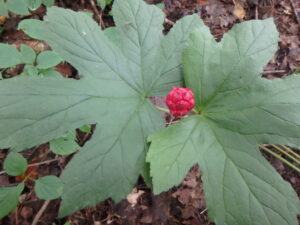
Golden seal fruits are ready for picking in my woods right now
Plants with large, fleshy fruits such as Jack-in-the pulpit or golden seal probably will require you to remove the fruit portion before planting. Gloves are suggested, as some have strong chemicals that may irritate your skin. You can soak seeds like that to allow fermentation to remove the skin and flesh.
A good reference text for anyone interested in starting wildflower seeds is by William Cullina, Growing and Propagating Wildflowers of the United States and Canada. Unfortunately, it is out of print, though I’ve heard it is in the process of being reprinted. It is worth its weight in gold as it gives specifics for each of hundreds of wildflowers.
So try collecting some seeds, and schedule a visit to Nasami Farm or the Garden in the Woods.
Henry is the author of 4
gardening books. He lives and writes in Cornish Flat, NH. His web site ids
www.Gardening-guy.com.
Bedrock Gardens in Lee, New Hampshire is Well Worth a Visit
Posted on Tuesday, August 17, 2021 · Leave a Comment
I recently visited Bedrock Garden in Lee, NH and came away feeling refreshed and enlightened. This 37-acre public garden was created on the premises of a 1700’s farm that was purchased in 1980 by artist and garden designer Jill Nooney and her husband, Bob Munger.
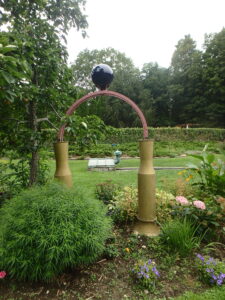
Gardens and sculpture go well together
Jill Nooney is a talented designer, who has won many awards at the Boston Flower Show. She is a welder who uses her skills to create metal sculptures from small to mammoth, as well as working with other media. Bob is a natural builder and fix-it guy who has enabled Jill to install her art in the landscape, along with water features, walls, paths and much more. They are a couple who really bring out the best in each other.
When I toured the gardens I was lucky to have had Jill as one of my guides. Also touring the gardens with me was John Forti, Executive Director and Horticulturist of the non-profit that manages the gardens. We spent nearly three hours together looking at the gardens and I learned about many plants I had never seen before.
Bedrock Garden is full of surprises that delight, enlighten and inspire visitors. I came away wishing I had a bigger garden space for my own efforts, and an appreciation for how much Jill and Bob have packed into their gardens.
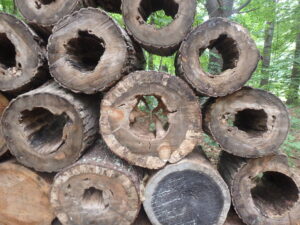
The Log Jam is something anyone could do
For years Bedrock Garden was open a few weekends each summer, but five years ago Jill and Bob decided that since they were approaching what some call “retirement age”, that they needed to look seriously at the future of the gardens. They created a non-profit, hired John Forti as the director, and figured out how to separate the public and private spaces.
During the pandemic they created a parking lot and visitors center that are accessed away from their home, the old farm house they have lived in for over 40 years. They have created a space that is family-friendly that delights children as much as their parents.

This gnome house near the parking area alerts children that they are welcome
Near the parking lot is a gnome house kids can enter made from a huge hollow sycamore log that Jill capped with a steel roof reminiscent of mushroom cap. She saw the wonderful hollow log alongside the road and hit her brakes immediately to ask for it. Luckily, she was the first to ask, and got it. (Five others stopped and asked for it that day, she told me, but she was the first).
I consider myself well exposed to the palette of plants available to gardeners in New Hampshire. Bedrock Garden is in Zone 5b, meaning that most years it does not get colder than minus 25 degrees Fahrenheit. But Jill has installed and grown many plants that I have never seen before, including many woody plants normally found in Japan or China.
Jill Nooney has used plants in ways that surprised me. So for example, she used ‘Bulls Blood’ heritage beets in a flower bed for their deep purple leaves. An annual effort, but very striking. When a hollow tree was cut down, she had Bob cut it in two-foot sections and stack the sections between two trees so viewers walking by could see through it like binoculars. One can see where branches had been swallowed by its growth. They call it “Log Jam.”
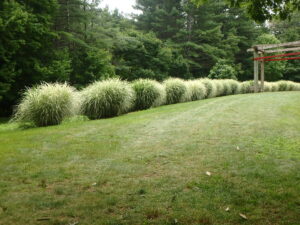
Decorative Miscanthus grass makes a statement in full sun
Jill has used decorative grasses well throughout the garden. Fountain grass (Miscanthus spp.) is a genus of grass that gets to be more than six feet tall and very bushy in full sun, where she grows it in an “allee” arrangement that is gorgeous. But she also uses it in shade. “It’s wispy in the shade”, she said,” I like that.”
Metal sculpture is a key element throughout the garden. Early in our tour I admired a space made by forming ¾-inch steel rebar into a series of 11 arches 13-feet tall and spaced 7 feet apart. “I’m using the sky,” she said. She consciously mimicked the lines of a Gothic cathedral, bending each steel frame to a gracefully pointed Gothic arch. And she is growing European fastigate beeches to clothe the metal frame as part of the installation: one on each side of the archways and tied to the steel. They will eventually reach the sky – the apex of the arch.
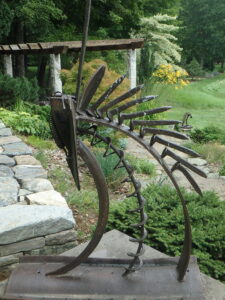
A steel chiwara or stylized antelope mask in the garden
Also in the garden are two iron “Chiwaras” modeled after antelope masks made by the Bambara people of Mali. Many years ago I had told Jill the legend of the antelope in Mali, where I had worked with the Peace Corps. The Bambara people credit the antelope for teaching them to plant millet, their primary grain. The antelope pawed the ground, and dropped a little manure into the soil containing seeds. So they honored the antelope with their stylized masks, which Jill captured beautifully.
So plan a visit to Bedrock
Garden if you can. There is a guided tour each day, and two on weekend days. Or just wander around and study the design elements – see how Jill has used plants that awe and inspire, and how she has added whimsy and art that delights and amuses. This is a
garden worth visiting even if you don’t have a big space or the energy to develop it the way Jill and Bob have. Bring a lunch and plan on spending the day. You’ll be glad you did. And if you have children in your life, think about attending the Fairy Hobbit House Festival October 9 to 11. Learn more at
www.bedrockgardens.org.
You may write Henry at PO Box 364, Cornish Flat, NH 03746, or e-mail him at
henry.homeyer@comcast.net. Please include a SASE if you want a response by mail.
On Becoming a Plant Collector
Posted on Wednesday, August 4, 2021 · Leave a Comment
I’ve always been a gardener. –or at least as far back as I can remember. More recently, say the last 20 years or so, I’ve been a plant collector. What does that mean? If I fall in love with a plant, I want to grow other plants related to it.
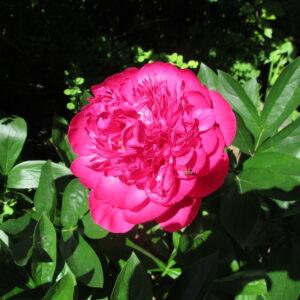
Collector Bill Countryman started out with one peony and eventually collected about 600 varieties
One of the most obsessive collectors I ever met was the late Bill Countryman of Northfield, Vermont. When I interviewed him in the late nineteen nineties he told me that his sister sent him a peony, and although he was in his seventies at the time and not a gardener, he planted it. It bloomed magnificently and Bill fell in love with peonies He decided to grow every type there is.
Bill Countryman bought a chain saw so he could clear his land to plant peonies. He bought a bulldozer to remove the stumps and went to work. When I met him, he had already planted some 300 kinds of peonies, though he continued on, getting more varieties – perhaps as many as 600. He sold them, but mostly he just enjoyed them. He was quite the collector.
I’m not nearly so obsessive. What do I collect? Well peonies, I suppose. But Cindy and I have only 44 peonies. Primroses. Burnets. Persicarias. Wildlflowers. Willows. I have dozens of colors of daylilies, but don’t consider myself a collector of them – they are just nice, reliable plants, but I don’t need one of every kind. Thank goodness for that- there are many hundred.
The burnets are quite a diverse group in the scientific group or genus, Sanguisorba. First I got the one native to New England, Sanguisorba canadensis. It loves wetlands, so I planted it in a weedy, marshy place in part sun/part shade. It thrived, sending flower spikes with bottlebrush flowers 6-feet tall or more. It blooms in late summer or fall, and can still be pretty in late October.
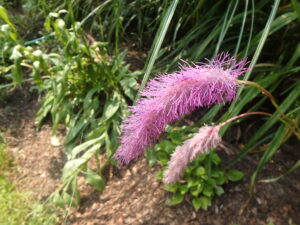
Lilac Squirrel Sanguisorba blossoms are delightful to touch and see
My absolute favorite of these flowers is one called Sanguisorba hakusenensis ‘Lilac Squirrel’. I saw it on-line, and asked all my local garden centers to no avail, so I finally ordered it from Digging Dog Nursery in California. I planted five small plants last year, they wintered over, and are blooming now. The flowers are like pink squirrel tails hanging down from 18-inch flower stems. They make me smile, especially with a name like that.
The littlest of the burnets I grow is one called S. officinalis ‘Little Angel’. It makes a tidy clump of diminutive green leaves edged in white. Each leaf is just half on inch long. The deep red catkin-like flowers are on 6-inch stems that lean or fall over. Now, five years since I bought it, the clump is about a foot across and just 3 inches tall.
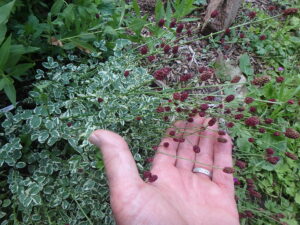
Little Angel is dwarfed by its larger relatives
Little Angel’s bigger cousin in the same genus is one called ‘Tanna’. This is called a miniature, but that is only relative to some of the bigger ones that get 4- to 6-feet tall. It has very tidy 18-inch leaf stems, each with 13 to 17 leaflets in dark green. It makes a tidy mound and has the same dark-red smallish flowers.
Of the large ones that are garden worthy, I have two: probably S. obtusa and S. tenuifolia. The literature, even on-line, is sketchy about identifying these plants and I lost the plant tags long ago. The first, which has reddish-pink tidy small catkin-like flowers needs to be tied up early in July. If not tied up, the flower stems, which get to be over 4-feet long and have 20 or so blossoms per stem, flop over. The other is standing tall and proud right now, but the flowers have not yet opened – and I haven’t staked them.
Why do I collect burnets? I just like them. They can be picked for flower arrangements, but I rarely do. I like seeing them in the garden.
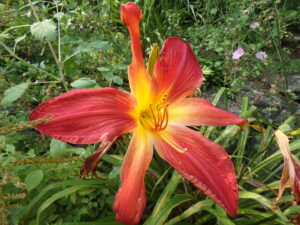
I have dozens of daylilies but don’t consider myself a collector of them
Willows, of course, are more of a problem to collect because of their size, but I do grow at least half a dozen. My favorite is the Salix integra ‘Hakuro nishiki’. It has variegated foliage early in the summer – green and white, and then with pink mixed in for a few weeks. It is colorful and fast growing. Like all willows, it appreciates moist soils but will grow in ordinary garden soil.
‘Hakuro nishiki’ is not a large willow. It seems to top out at about 20 feet in 10 years. I planted three some 20 years ago, ten feet apart, and they created a dense grove. I was able to prune out branches growing into the center, creating a small room where I placed Adirondack chairs. It makes a cool space near my brook to eat lunch on a hot day.
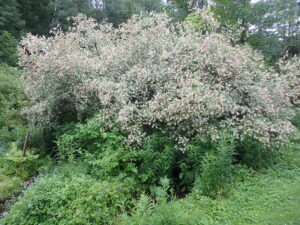
Hakuro Nishiki willows have tri-colored leaves in early summer
The rosemary willow ( Salix eleagnos) is another favorite of mine. It is a small willow, only getting to be about 10 feet tall and wide in 10 years. I love that its leaves look somewhat like leaves of the herb rosemary: narrow and pointy leaves. They are dark green on the top side, gray or silvery on the bottom side. I’ve almost been able to fool people visiting my garden into believing it was really a rosemary plant on steroids– but for the lack of smell. Neither the rosemary or Hakuro nishiki produce any noticeable flowers.
So I encourage you to look for – and collect – plants related to the ones you love. Not every variety will tickle your fancy, but if you discover a few that do, they will make you happy for years to come.
Invasives and What to Do About Them
Posted on Tuesday, July 27, 2021 · Leave a Comment
Since ancient times, explorers have brought back seeds and plants from exotic lands. Some, like the apple, have been a boon to the citizens of their adoptive home. Others, like the notorious Japanese knotweed (a.k.a. “bamboo”) have been more headache than boon.
New England, with its cold climate, is blessed with a natural defense against some invasives: our winters. But many others have settled in and are taking over – or trying to. It is up to us, the gardeners, to be responsible: we need to learn what the problem plants are, and we need to get rid of any we have growing on our property.
Invasive plants are those that reproduce rapidly and take over wild habitats, out-competing the plants that Mother Nature provided, stealing light, water and nutrients from less aggressive plants. By definition, they are alien species, plants that have come here from other countries. These plants are often very good-looking plants, but thugs.
Most invasives produce large numbers of seeds that are distributed by birds, by the wind, or by water. In most cases, invasives are also difficult to remove or eradicate once established, and have extensive root systems that preclude simply pulling them up.
Back home, in their country of origin, most invasives have predators – insects or diseases – that keep their numbers in check. They may have come inadvertently or been brought by well-intentioned people who thought they were pretty or had some use for them. Some, like burning bush, barberry and Norway maple, have been introduced and sold because they are essentially indestructible – and pretty.
For starters, you can learn to identify the prohibited species in your state, and eliminate them on your own land. Check with your local University Extension service to obtain a list for your state.
Getting rid of invasives, however, may not be easy for two reasons: you may like the invasive species, and may have planted it before you knew better. Secondly, it may not be easy to eliminate – even with the use of herbicides (which you probably don’t want to use anyhow).
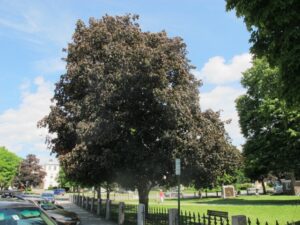
‘Crimson King’ Norway maple looks great, but out-competes our native maples in the forest
The Norway maple, for example, is a lovely-looking tree that grows fast and survives well even in urban areas. It will grow in sun or partial shade and is not bothered by road salt. If you have one that is shading your house, I can understand why you might be unwilling to cut it down.
If you are a city dweller, you may assume that since there are no forests nearby, it shouldn’t matter if you keep your Norway maple (or other invasive species). But it’s not just wind or birds that distribute seeds. Runoff can carry seeds to an outlet in a natural environment. Seed from your tree can end up in streams, rivers, ponds. Thus even city dwellers can make a difference, helping to control the propagation of this invasive tree by cutting down theirs.
To see if maple trees growing wild near you are Norway maples, do this simple test: snap off a leaf at its attachment point, and look at the stem. If it oozes a milky sap, it’s a Norway maple. The leaves also tend to be broader and larger than sugar or red maple leaves.
For organic gardeners, getting rid of invasives is not easy. For herbaceous weeds, think lawnmower. Once you have the stalks (and as much of the root mass as possible removed), plant grass seed. Mow it every week and the roots will not be get recharged. Stems will continue to grow for years, but if you mow it, you can win.
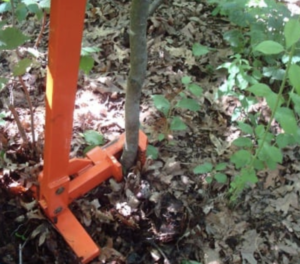
There are several brands of weed wrenches that can help to pull small trees and shrubs
Digging the stump of an invasive shrub like barberry, bush honeysuckle or burning bush is a pain in the neck, but you probably can do it. Digging the stump of a large Norway maple is not practical. But there are folks with back hoes and stump grinders, and the expertise to do it.
If your woods are full of small seedlings of invasive trees or shrubs, you may wish to get a tool for pulling saplings called a weed wrench. This tool has a gripping mouth-like part, and a long handle to provide the leverage. A weed wrench of the proper size allows a 150 pound office worker to pull out shrubs and small trees that otherwise would not be possible to yank.
Why bother digging out invasives? You may decide to do it for the sake of your grandchildren, or for the environment. Even in states with good laws prohibiting the sale of invasive plants, no one can force you to cut down or pull out your invasive plants. But being a little selfish is okay, too. Think of all the great plants you can buy and plant if you get rid of those invasives. And think how wonderful it would be if wildflowers and native plants started flourishing in your woods.
Henry Homeyer is an organic
gardener and longtime UNH Master
Gardener. Reach him at
henry.homeyer@comcast.net or PO Box 364, Cornish Flat, NH 03746.
Mulch Can Help Keep Down Weeds
Posted on Tuesday, July 20, 2021 · Leave a Comment
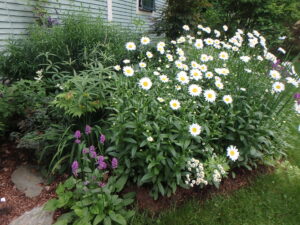
Little or no mulch is needed in a mature garden bed with plants growing shoulder to shoulder
Mulch is commonly used to help suppress weeds and to hold in soil moisture in dry times. There are many different kinds of mulch and it is important to get the right kind, and to apply it properly if you wish to get the benefits of mulch.
The most commonly used type in flower and shrub borders is sold as bark mulch. It is sold in bags, or by the scoop at garden centers to people who have access to pickup trucks. Bulk mulch is less expensive than bagged mulch if you have a truck, or can borrow one from you brother-in-law.
I’m an organic gardener, so I avoid the orange and black mulches. Read the bag before you buy any to see what is in it. According to a report from the University of Massachusetts, the dyes themselves are probably not toxic, but the wood is usually recycled wood from pallets, old decks and scrap. Those sources are dry and accept dye more easily than fresh bark or chipped branches. Recycled pressure treated wood, if older stuff, may contain arsenic; pallets may have been exposed to spilled toxins.
I often see deep layers of mulch to keep weeds down. However, a layer 4 inches deep will also keep a short rain shower from getting to the soil and your plants. I use an inch or two of mulch, maximum. Yes, some aggressive weeds will poke through a thin layer of mulch, so I try to do a good weeding first.
Chopped leaves are wonderful mulch. Last fall we raked up our leaves and stored them outdoors in a pile. This summer we ran that pile through a chipper/shredder and turned it into a fine product we use as mulch. You can also use your mower to chop fall leaves before raking them. I have friends who store the chopped leaves in bags in the barn until needed. Chopped leaves rarely blow away after they have been rained on.
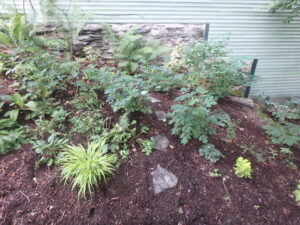
This new bed needs mulch to keep down weeds and hold in moisture
In addition to weed suppression, a layer of mulch keeps soils from drying out quickly in the hot summer sun. Essentially, it shades the soil, keeping it moist and cool. In the spring I do not mulch my vegetable garden until after soil temperatures have reached their summer level – say 60 degrees or more.
In May, I want the sun to heat up the soil as my plants need warm soil to grow in, and seeds need warm soil to germinate. And yes, that means weed seeds will germinate, too. But weeding or hoeing the early weeds is not bad and goes quickly – just be sure to get the weeds before they get too big.
Mulch gets broken down over time by soil microbes. That is a good thing – wood chips or leaves that break down add organic matter to your soil and encourage earthworms to aerate the soil and add their castings to the soil, and they are rich in minerals –
Some gardeners tell me that they worry about soil microbes using up nitrogen in the soil as they breakdown mulch. A nitrogen-starved plant has yellowish leaves, not dark green leaves. But I doubt that you‘ve seen that occur, even in flower beds with plenty of mulch. If it has been a problem, or you worry it will occur, apply some slow-release organic fertilizer on the soil surface before mulching.
In the vegetable garden I mulch with straw or hay. Straw is sold as seed-free and is often grown and cut before seeds are formed. Nonetheless, straw often does have seeds, much to the dismay of gardeners who have paid a premium price for it. Buy it from a source you trust!
Hay is just grass grown for animal feed that has gotten wet after cutting. Those pampered cows or horses won’t eat it, so it is sold as mulch for a few bucks a bale.

Newspaper around tomato plants will be covered with straw
I always lay down two to four layers of newspaper on the ground before applying hay or straw. This accomplishes two things: it keeps light away from any weeds that germinate even with a layer of hay, and it slowly breaks down and adds more organic matter to the soil.
In the old days newspapers used dyes with heavy metals, including lead. But now inks are made with soy products and are said to be non-toxic, or at least free of heavy metals. The newspaper itself is made from cellulose derived from trees, though some chemicals are used in producing the paper.
Black plastic will keep weeds from germinating, but it breaks down and goes into the landfill. It’s also ugly, and I avoid it. There are various “landscape fabrics” to put under mulch that do help, though pernicious weeds can grow through some kinds. The woven kind is more susceptible to that.
What about papers that have been through a shredder? I don’t find them easy to use or aesthetically pleasing. What about coffee grounds? These are quite acidic, and if you collect them at your local coffee shop, use them only for acid-loving plants like blueberries, hollies or azaleas.
I use no mulch in my mature flower beds. By letting perennials mature and spread, they will choke out almost any weeds, except perhaps in early spring. But by now, they shade out all but the most difficult of weeds.
Is It Time to Grow Up? Vines Offer Special Features
Posted on Tuesday, July 13, 2021 · Leave a Comment
The story of Jack, of Bean Stalk fame, appealed to me as a boy, and still does. I love climbing vines and grow many including those that are perennial or annual flowers, and some vegetables. Vines are a great way to save space and to get blossoms up and visible.
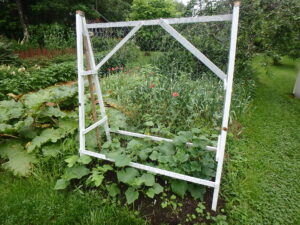
A cucumber trellis is easy to build
In the vegetable garden I have had great luck growing cucumbers on trellises. I made a simple frame to support my cukes, and you can, too. You can use 4 six-foot long 2-by-2 pieces of lumber for the framework. Attach them in pairs with simple gate hinges from the hardware store. Then space them five-feet apart with pieces of strapping at the top and bottom, and attach chicken wire for the vines to grab onto.
I used a cordless drill and short sheet rock screws to put it all together. I made it sturdier by cutting short pieces of strapping to go from the front legs to the back legs. To ensure it doesn’t blow over, I drove in a hardwood grade stake into the ground on each end, and screwed it to that strapping. Once the vines are long enough, lift them up onto the chicken wire, and they will quickly attach to it and grow up.
Other vines will grow up on trellises, too, including squashes and gourds of all sorts. For heavier fruits you may want to build your trellis with two-by-fours, and perhaps to use stronger wire mesh or the stuff used to reinforce concrete that comes in 4-foot by 8-foot pieces.
If you have only grown bush beans, you should also try pole beans. As the name implies, these will encircle a pole and grow up 8-feet or more. The great thing about them is that if you keep on picking them, they will produce beans all summer. Bush beans produce just one load of beans over a 3-week period, and then they are done.
Beans fix nitrogen, taking it from the air and storing it in useable form in nodes in the roots, but only if the soil has a certain bacteria to work with your beans. You can buy ‘inoculant’ to make sure your beans do fix nitrogen, and can add some to the soil and water it in, even now.
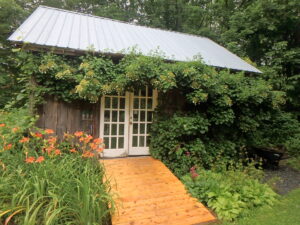
Climbing hydrangea covers the north side of my barn and looks good all year
Climbing hydrangea is a perennial woody vine that looks good all year. It is slow to get started, but once established (after a few years) it grows quickly. It does well on the shady north side of a building, a place often difficult for flowers. It will attach to brick or stone, but needs to be attached to a wood building, either with a trellis or individual ties. It blooms in June, but the large white panicles look good long after, even into winter.
There are many types of clematis but all have wonderful blossoms, some 6-inches wide or more, others small but profuse. Most will grow 6 to 10-feet tall; some die back to the ground each year, others have woody vines that send out new shoots and flowers each year. The key to success is to give the vines plenty of sunshine, but to protect the roots with shade from other plants to keep them cool. There are spring, summer and fall bloomers. Some are fragrant, others not.

This fall-blooming clematis had hundreds of blossoms
If you have lived in a warmer part of the country you may long for wisteria, a woody vine that blooms profusely with blue or purple flowers, and occasionally in shades of pink and white. Each blossom is actually a cluster of blossoms that hang down like a cluster of grapes. Although most wisteria varieties will survive our winters, most bloom on “old wood” and the flower buds get killed in winter.
I grow two varieties that do bloom in Zone 4 because they bloom on “new wood”, or this year’s growth. One is called ‘Blue Moon’, a hybrid developed in Minnesota. The other is ‘Amethyst Falls’, a native variety with smaller leaves and blossoms. Both bloom for me in late June or early July, and re-bloom lightly throughout the summer.
Annual vines are vigorous and delightful, too. We generally grow morning glories from seed. These come in many colors: reds, pinks, blue, purple and white. My favorite is called Grampa Ott. It is a deep purple, and can grow up to 15 feet in a season. It was one of two heritage plants that inspired the creation of the Seed Saver organization and seed company. They grow quickly so it’s not too late to plant some by seed.
Two decorative flowering beans that I like are purple hyacinth bean and scarlet runner bean. The purple hyacinth bean is a beautiful plant: the leaves are purple, along with the flowers and seed pods. It is slow to germinate and get up a pole or trellis, so it is best started in pots indoors before it can be planted outdoors. The young beans are edible raw or cooked, but the mature pods has seeds better used as dry beans.
Scarlet runner beans, like the hyacinth bean, can climb up a support and grow 10-feet in a season. They are quicker to grow than hyacinth beans, and I often start them in the soil near my hexagon cedar shade structure where I also grow wisteria. The bean has bright orange flowers and standard bean leaves. Plant 4 to 6 seeds around a pole and watch them grow- just like Jack, the bean stalk kid.
Mid-Summer Blossoms
Posted on Tuesday, July 6, 2021 · Leave a Comment
Mid-summer is often a quiet time for flowers – many gardens have fewer dramatic blossoms than in the spring. I have made an effort to have plenty blooming now. It’s true that my Japanese primroses, peonies and Siberian iris have gone by. But I have many others, both old favorites and lesser-known beauties.
Beebalm ( Monarda didyma) has started early this year for me. Contrary to what most gardening books say, beebalm does not need full sun. In fact, full sun makes it dry out and go by more quickly. It does well in moist, rich soil but will grow anywhere. This year I planted some wild beebalm, a native prairie plant. Its scientific name is Monarda fistulosa, and some better garden centers are selling it now- even though it is not as flashy as its domesticated cousin. It’s a light lavender in color, and shorter than the standard varieties. It is terrific for butterflies and bees.
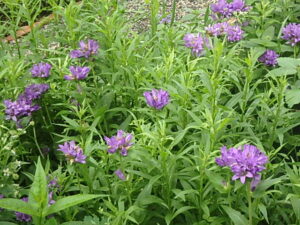
Campanula glomerata spreads by root but it is not a thug
Just finishing up for me is one of the bellflowers, clustered bellflower or Campanula glomerata. It stands about 24 inches tall with purplish-blue globes of small blossoms. It is a fast spreader, but pulls easily if it gets out of its place. A relative, peach-leaved bellflower ( C. persicifolia) is preferred by some, as it is better behaved. It has flowers growing up its tall stems, and comes in blue or white. Both species are good cut flowers.
Feverfew ( Tanacetum parthenium) has been used traditionally to cure many things, but I like it as a white cut flower with a yellow center. Each blossom is small – say half an inch – but there can be hundreds on a big plant. It is rambunctious. It sows seeds and shows up around my garden, but it is easily pulled. It keeps well in an arrangement.
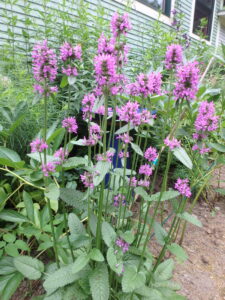
Betony humelo is a good cut flower
Betony (Stachys officinalis) is in bloom now, too. It is in the same genus as lamb’s ears, but has green, not silvery leaves, and sends up lovely purplish flowers on stiff stalks that look great in a vase. The best variety is one called ‘Hummelo’, named after the Dutch hometown of Piet Oudolf, designer of the High Line Gardens in NYC. But Hummel means bumblebee in German, which is appropriate – it attracts bees over its long bloom time. Small flowers appear all along its tall stems.
An uncommon flower in bloom for me now is called false hydrangea (Deinanthe caerulea) because the leaves are similar to those of the PeeGee hydrangea, although the flowers are totally different. This gem grows in full to part shade in moist, rich soil. It has small bluish-lavender cup-shaped flowers.
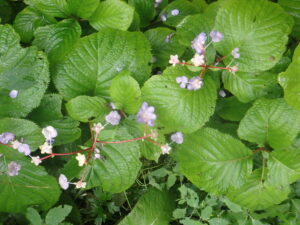
False hydrangea comes in blue or white blossoms
There is another false hydrangea, Deinanthe bifida, which has white flowers. Both are rated as hardy to Zone 5. I am in Zone 4 and have lost some plants, but others have survived.
A huge, dramatic plant is giant fleece flower (Persicaria polymorpha ). The blooms of this giant are a bit like astillbe flowers on steroids. The hollow stems stand up to 8 feet tall, and flower panicles are sometimes 18 inches from top to bottom. It does not spread by root, but each year the clump gets larger. I just cut back a good portion of mine, as the plant was shading out nearby plants. It would take a pickax and a strong back to dig it up – which I have, on one occasion. It likes moist soil and full sun,
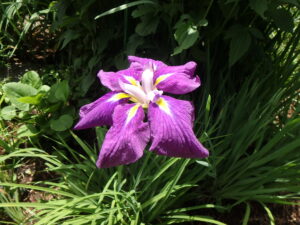
Japanese iris love wet places to grow
Moist soil is also good for Japanese iris (Iris ensata). In fact, it is often grown in shallow water. I have one clump which has just begun blooming – after all the others. Its foliage is similar to Siberian iris, but the “falls” or petals lie back flat, looking up. It does not like the competition of weeds, I have learned, as we weeded it well early on, and it is going to bloom dramatically this year.
Great masterwort ( Astrantia major ) has small domed blossoms in white or pinky-purple that look like pins stuck in a small pincushion, surrounded by delicate bracts (petal-like structures). Deer won’t eat it, and it blooms for weeks, preferably in moist, sunny locations. Each year my clumps get bigger and more wonderful.
At the front of a prominent flower bed I have installed lady’s mantle (Alchemilla mollis ), a tidy plant with lacy clusters of chartreuse flowers, a color that accents others nicely in a vase, or in the garden. It is probably best known for its tidy foliage which traps rain drops or dew and shows them off. It works as a ground cover, spreading a bit each year and providing dense foliage that helps reduce weeds. It will grow in full sun or light shade, but does not thrive in hot, dry soil.
In addition to perennials, each year I grow some annuals. Last year we started many dahlia tubers for their big, colorful blossoms, and saved the tubers indoors to reuse this year, and to share with others.
This year we bought some canna lilies for their interesting foliage – one variety has deep purple leaves – and bright orange or yellow flowers. They stand from two to six feet tall, and have been blooming consistently for a month so far.
If your garden is a bit short of flowers just now, try some of those mentioned above. There is always space for a few more flowers.
You may reach Henry at PO Box 364, Cornish Flat, NH 03746 or by e-mail at
henry.homeyer@comcast.net. He is the author of 4
gardening books.
It’s Time to Prune Trees and Shrubs
Posted on Sunday, June 27, 2021 · Leave a Comment
By now your rhododendrons, lilacs and other spring bloomers have bloomed, and are ready to prune. By pruning now, you will not damage buds that will form later this summer and bloom next spring. This is also a good time to prune evergreens like pines and hemlocks if you are trying to control their size.
Let’s start with rhododendrons and azaleas, as many gardeners seem to put off pruning them until they are blocking the view out the windows. If you just want to keep your rhododendrons the same size this year as they were last year, pruning it easy: you just look at the color of the stems, and cut off the new growth which is bright green. Older growth is tan or brown.

Use good sharp hedge shears to prune boxwood
Make your cuts just into the green growth. By doing so you are leaving a growing point for new growth next spring. Most rhododendrons blossom on old wood, which is to say growth that occurred the year before.
But what if you want to seriously reduce the size of your azalea or rhododendron? You can make your cuts farther down the stems. Make cuts just above a fork or place where branches grow in two or more directions. You will be cutting away the growth of two, or even three years growth. There are dormant buds on those bare stems, and they will start new growth. The farther down the stem you cut, the longer it will take for growth to begin.
Most rhododendrons keep their leaves all year, but many azaleas drop their leaves and grow all new leaves each year. The old leaves of evergreen species will be a darker color than new leaves, making it easy to see new growth. By the time you read this – depending on your climate – some evergreen rhododendrons will have sent out new shoots after the flowers bloomed. In the middle of a cluster of light green leaves you may see a small very pointed bud. That is next year’s flower.
If you want to shape or reduce the size of your shrub and see new leaves and flower buds, you must make a decision: which is more important? Next year’s show of flowers, or getting your shrub under control? I say (as the Red Queen said in Alice and Wonderland), “Off with its head!” Since pruning is so easily put off for another year, just do it now – even if it means sacrificing some blossoms. There should always be more blossom buds that will appear later this summer.
Lilacs should ideally be pruned two to three weeks after pruning, but can be done now, too. Buds are developed over the summer at the tips of branches to bloom next spring.
If your lilacs are not blooming as well now as they have in the past, it may be because the soil pH has gotten acidic from acid rain, or from pine needles. You can collect a soil sample and send it off to your state Extension Service for testing, but if only want to know the pH, you can buy a simple test kit at your local garden center or hardware store.
Lilacs perform best with a soil that is near neutral (pH 7.0), or slightly higher and more alkaline. The soil test or pH kit will tell you how many pounds of lime to add per hundred square feet, but that is difficult to translate into action. So often I just wing it: I add lime around the base of a lilac and out three or four feet all around. I measure it out in a one-quart yogurt container. One quart for small lilacs, two for big ones. Not precise, but it helps. Do that now – lime takes time to change the pH.
If you have a pine, hemlock or spruce in your yard or up against you house, you would probably prefer it to stay the same size, or at least not to tower over the house. It’s easy to do: YOU MUST PRUNE OFF THE NEW GROWTH EVERY YEAR. Just look at the tips of the branches now. You will see that this year’s growth is a slightly different color than the rest of the branch. Just snip that off. Do it right away, this is the time to do it.
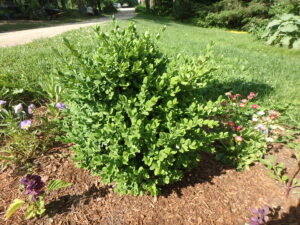
This young boxwood needs a light haircut to shape it
British gardeners – and hence, many American gardeners – love boxwoods. They love hedges and portly round balls. Some even create rabbits and other silly sculpture called topiary. If you have boxwoods, they need a light haircut every year in June or July. Never prune them after August, because pruning stimulates new growth and it will be tender, and turn brown and ugly in winter.
Prune your boxwoods with a good pair of hedge shears. Mine are about 24 inches long, with 9-inches long blades. Don’t use old rusty ones, buy a good pair such as those made by Fiskars or Barnell. Most Fiskars tools are good quality, and sold at a reasonable price. I don’t recommend electric hedge shears because they can ruin a shrub in the time it takes you to sneeze. I like light-weight shears for big jobs.

The same boxwood after pruning
When pruning boxwoods, just take a little off with each snip. You can work quickly, but just take a little at a time so you can get the exact shape you want and don’t create holes with a big cut.
Pruning can be fun. You can create a lovely piece of art if you take your time and step back to look at it as you go along. And if you goof, and create an “oops”, well it will all grow back. So go for it!
Henry is a professional pruner and
gardening consultant living in Cornish Flat, NH. Reach him at PO Box 364, Cornish Flat, NH 03746. Please include a SASE if you want a response by mail. E-mail is better and faster:
henry.homeyer@comcast.net.
What to Do with a Dead Tree?
Posted on Wednesday, June 23, 2021 · Leave a Comment
If you are a regular reader of this column, you know that I kill plants (just like you probably do). Houseplants. Annuals Flowers in the ground. And yes, even trees. Although some oaks live 400 years, most plants naturally have a much shorter life span. And although some die due to my negligence, most do not. But I do push the limits of Zone Hardiness, trying plants that rather would winter in Pennsylvania – and occasionally killing them.
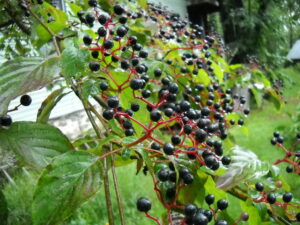
Pagoda Dogwood berries are loved by birds
I have a native dogwood tree that shows up all over my property. It is called the pagoda dogwood ( Cornus alternifolia) and is one of my favorites. This small tree never gets much taller than 10 feet, has just finished blooming with understated white blossoms, and has blue berries loved by birds in July or August.
But it has a short lifespan for a tree: 25 years is a good run for this one, even in the wilds. Fortunately it seeds in, so I always have plenty. When one dies, I can cut it down, thank it, and get rid of it. No mourning.
For the last 20 years or more beds I have had a hazelnut tree called Harry Lauder’s walking flower stick (Corylus avellana Contorta ‘Purple Majesty’ ,) in one of my flower beds. This tree is a naturally-occurring freak: its stems twist and turn in unusual ways. Great in winter for its silhouette, mine also had purple leaves and was a great tree. I pruned it to keep it just six feet tall. But last summer it showed signs of distress, and this spring it did not leaf out. It is dead.
But because it is striking in profile, I decided not to cut it down. Not yet, anyway. I planted annual vines around its base and I am training them to climb up into the tree. If all goes as planned, in a month or so I will have purple hyacinth beans blooming in the tree.
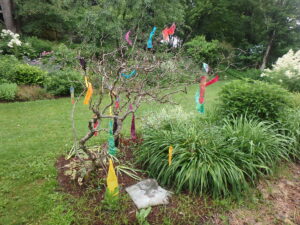
Colorful ribbons decorate this dead tree while vines grow up it
In the meantime, my wife Cindy and I decorated it with colorful strips of cloth. Each is just a couple of inches wide and perhaps a foot long. She attached threads to the top of each so we could tie them on like Christmas ornaments. Even the slightest breeze has them fluttering and twisting. It’s lovely.
Although nowadays I buy almost exclusively native plants, last summer I was tempted by a lovely Japanese clethra (Clethra barbinosa), and brought her home. This spring it did not leaf out, a major disappointment. My test for a dead branch is to rub my fingernail on the bark, scraping off the outer layer. If it is alive, it will show some green. But this clethra showed brown everywhere, and I decided it was dead.
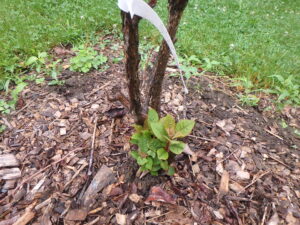
New growth from the roots may bring this Japanese clethera back to life
As I was lopping off the branches prior to digging it out, I noticed a few leaves growing at the very base of the tree. Life! So I am letting it stay. Unfortunately, I do not know if the tree was grafted onto a different rootstock, which is common in the landscape trade.
So, for example, a branch or branches of a Japanese clethra might have been grafted to a summersweet clethra ( Clethra alnifolia). This avoids having to start a new plant from seed and ensures that the new plant has the desirable characteristics of the plant grafted to rootstock. If the rootstock grows, one gets a plant different from the purchased plant.
All apples are grafted onto rootstock because the seeds are hybrids and will not breed true. The rootstock used for apples determines the size of the tree. Some will produce miniatures, others full-sized trees. So if your apple is killed by rodents last winter and the roots sent up new shoots, what you get will probably not be interesting to eat. Yes, Johnny Apple Seed traveled around America with a sack of apple seeds, but those apples were for making hard cider, America’s beverage of choice, not for eating apples.
If your rose died last winter, you might be able to bring it back to life. Most roses are sold on roots that are different than the flowering portion. You should be able to see a scar, the graft union, on your rose. If the union was planted below the soil line, the rose may sprout from the fancy rose you bought, not the rootstock. So wait and see what happens. By now, this late in the season, a “dead” rose should have sent up shoots if it is going to.
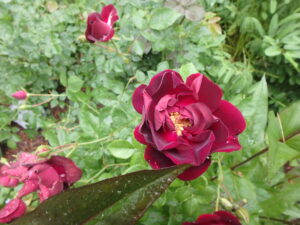
This rose grows from roots of a hybrid tea that died. Smaller blooms but nice.
Most plants we grow are vigorous and seem to have an innate “desire” to keep their genetic lines viable. That is why they produce seeds, and many (especially weeds) send out roots that can send up new plants. So if a perennial plant dies, you may be in luck. A baby plant may replace the mother plant. It’s what they do.
A few words of warning, however. Any plant that starts from seeds dropped by a hybrid plant will probably not breed true, although it can. A hybrid is a cross between two genetic lines, and seed producers develop them in carefully isolated circumstances to protect their lineage.
I like to think that if I never kill any plants, I am not trying hard enough. I try to grow new and different plants, often things that would rather grow a few hundred miles south. When those rare (for here) plants do survive and bloom, I feel like a million bucks. Hopefully they did not cost that much, as I will probably lose them at some point.
Henry is the author of 4
gardening books and is a
gardening consultant. He lives in Cornish flat, NH. E-mail Henry at
henry.homeyer@comcast.net or write him at PO Box 364, Cornish Flat, NH 03746. Please include a SASE if you want a response.
Summer Chores in the Vegetable Garden
Posted on Wednesday, June 16, 2021 · Leave a Comment
Summer Chores in the Vegetable Garden
As the song goes, It’s “Summertime, and the livin’ is easy!” Well, not really. Yes, I’ve planted my 53 tomato plants, 200 onions and more, but there is still plenty to do. Let’s look at a few chores you might want to do this weekend.
Your tomatoes need support. If they lay on the ground, or even on a nice bed of straw, they are more prone to diseases. They need air and sunshine to stay healthy and to ripen up sooner.
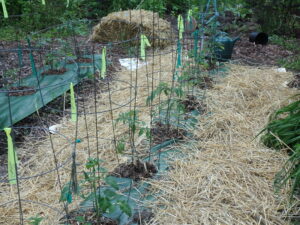
Tomato cages support your plants and hay or straw helps prevent soil-borne diseases scaled
I like wire tomato cages as supports. I recommend getting the biggest cages possible: 54 inches tall with four support legs instead of three. They are expensive, but last for many years. Right now your tomatoes are short, and standing up on their own. But if you wait too long, they will be much more difficult to install. Do it now!
If you grow a lot of tomatoes and don’t have the budget to buy nice cages, you can tie them to wood stakes. Get one-inch hardwood “grade stakes”. Five footers are best because you need to push at least a foot into the ground. Tie the plants to the stakes with something soft: strips of old sheets work well, or panty hose. If you use string it may bite through the stems when they are loaded with fruit. You will need to add more ties as the plants get taller.
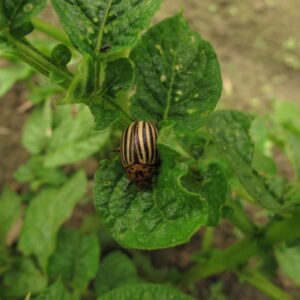
As your tomatoes get mature, you may notice that lower leaves are turning brown.
This is probably early blight, a common soil-borne disease. It is not fatal, but reduces your fruit production. You can minimize by doing two things: cut off affected leaves, and mulch the soil to minimize splash-up. Grass clippings, leaves or hay will help. They also keep the roots more moist in dry times.
If you are growing carrots or beets, this is a good time to thin them. You really should thin them by the Fourth of July. It is tedious work, which is why many seed companies are selling “pelleted” carrot seeds. These are seeds that are coated with a clay covering to make them larger, and easier to plant an inch or so apart. Beet seeds are actually seed clusters: several seeds are in each “seed”. So even if you spaced them carefully, they need to be thinned.
If you planted potatoes, now is the time to look for potato beetles, or their eggs on the underneath side of the leaves. The egg masses are bright orange and easy to spot. Scrape off the eggs into a jar of soapy water. If you see the beetles or their larvae eating the leaves, get them into the water, too. By reducing their population now you will reduce their exponential increase in numbers. If you see holes in the leaves, you have the beetles.
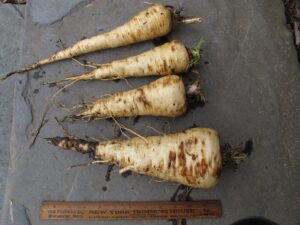
Parsnips will grow in soil suitable for carrots and are an early spring treat
This is a good time to plant parsnip seeds because they need warm soil to germinate. Keep in mind that the seeds do not keep well, so do not plant last year’s seeds. Most garden centers probably still have parsnip seeds because they are not a terribly popular crop. Parsnips store well over the winter – just leave them in the soil. I love them as an early spring treat: just boil them up, then serve them with butter and maple syrup. Yum! And don’t get discouraged if they take 2 full weeks to germinate, they are very slow.
I am eating lettuce from my garden that I planted early in the spring. That means it is time to plant some more seeds. Lettuce bolts when the summer gets too hot, which means that it elongates (reaching for the sky) and turns bitter before flowering and producing seed.
But there are summer varieties that are heat-resistant. Of the Butterhead lettuces, try Skyphos or Buttercrunch Bibb. Oakleaf lettuces such as Magenta do well, and a Romaine called Jericho does well in heat. Read the packages well or study a catalog.
Plant mid-summer lettuces where they get morning sun and afternoon shade if you can. You can also use shade cloth to protect against strong afternoon rays. Perhaps you can plant seeds in six-packs to get them going, then transplant them in your tomato patch where the big plants provide some shade.
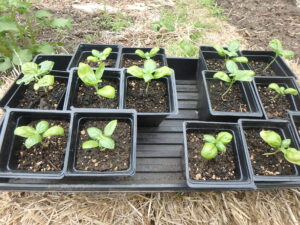
These little basil plants I started from seed and are ready to go in the ground
Pesto season is coming up in August, so plant some more basil by seed if you don’t already have enough planted. I like planting seeds in small pots to get them well established before planting them in the garden. But if you want a lot for pesto, dedicate a 6-foot row and plant plenty of seeds. They will do fine, even if a bit crowded.
Look around your garden now to see what you forgot to plant. For me this year, it was dill. No matter. I shall plant some by seed, and it will grow vigorously in the heat of summer.
If you have run out of space in the garden, think about creating a raised bed for those last minute plantings. Most garden centers sell metal corners to help you build your own raised beds, even if you aren’t a carpenter. Not only that, your local lumber yard will cut the boards to your specifications at no extra charge. All you need is a cordless drill and some outdoor screws to put a bed together in no time. Put a little bed on your lawn in full sun.
Don’t forget a few annual flowers in your vegetable garden to attract bees and butterflies. Most garden centers still have plenty of flowers that are in bloom and ready to plant. Just remember to tease the roots apart before planting now, as the little cells are often root-bound. So get outside, and get busy. It’s summer!







































